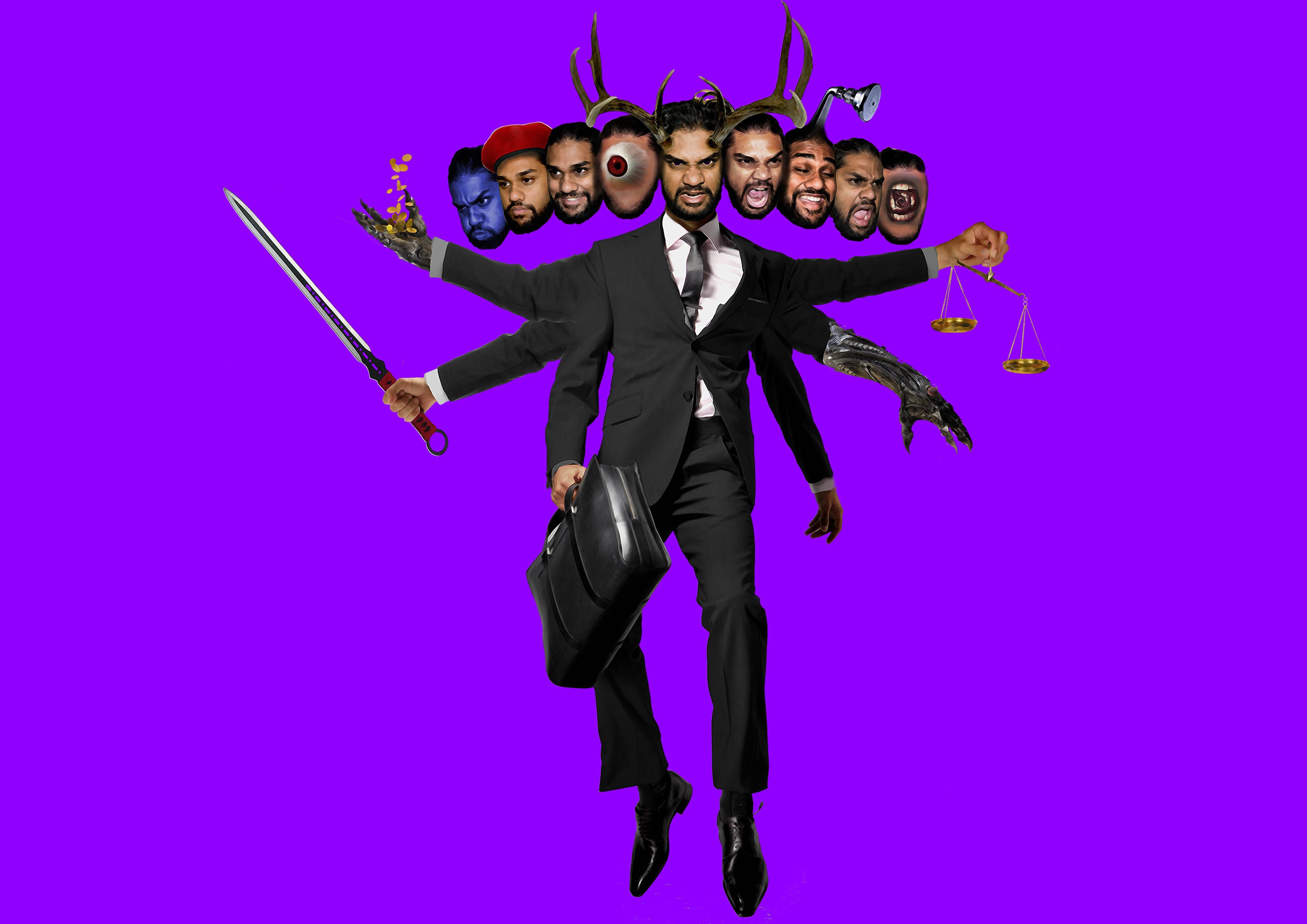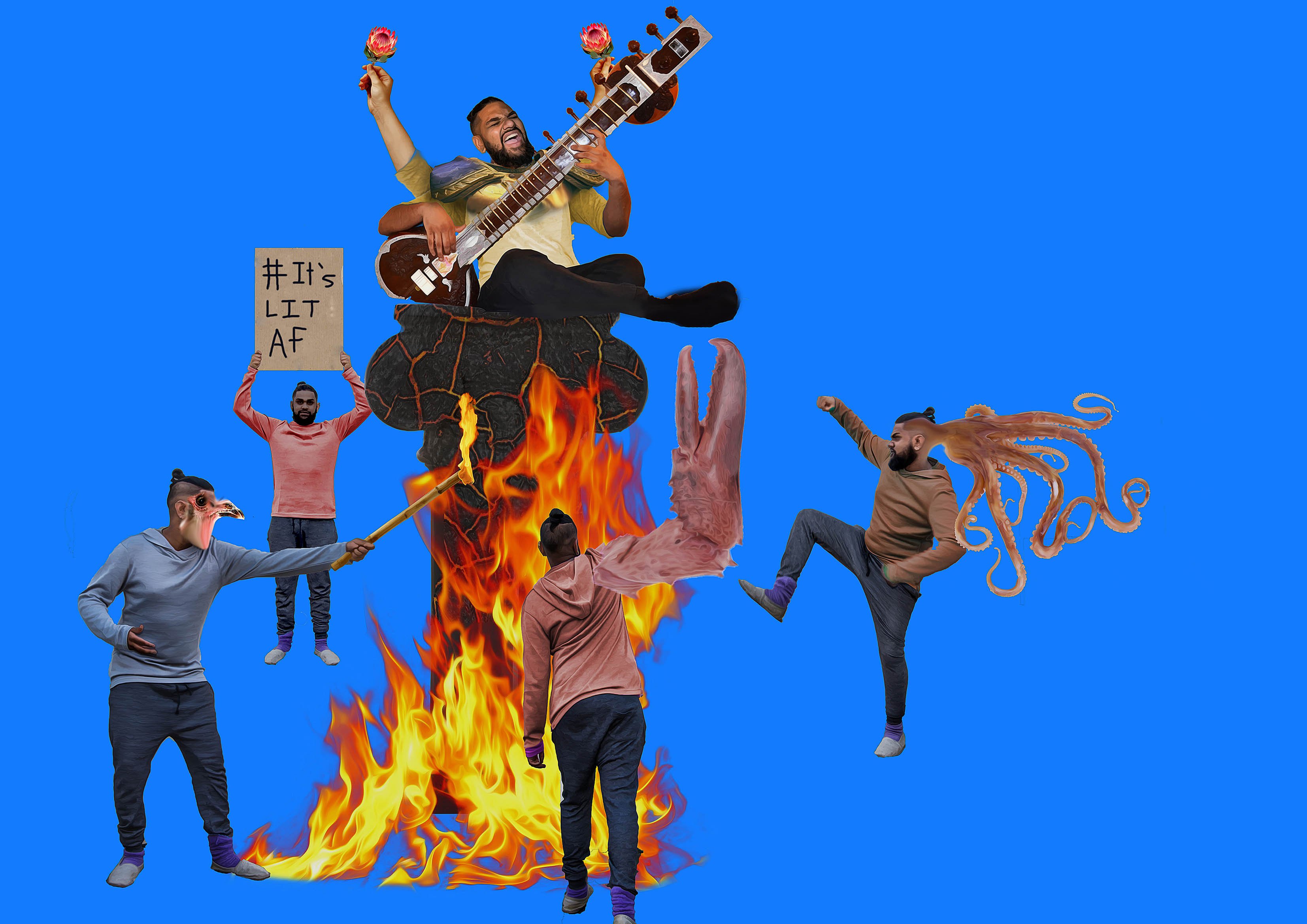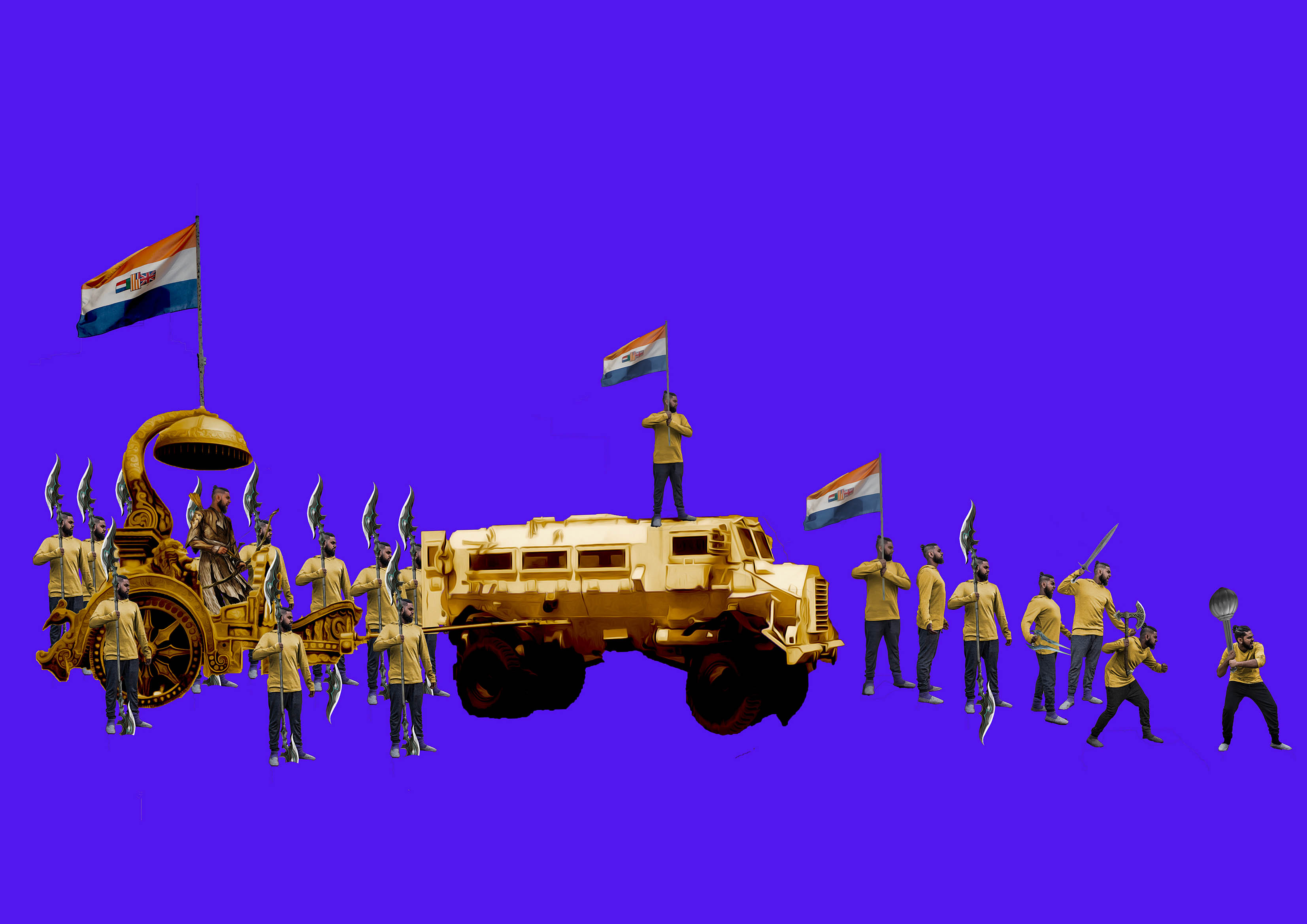Constant battle: In Not Even a Needles-width of Land, artist Kiveshan Thumbiran wishes to convey how being a South African Indian has positioned him on both sides of the narrative
Kiveshan Thumbiran’s exhibition title, Kaliyu-topia, is a hybrid word borrowing from Kaliyug, a Hindu reference to the end of time for humanity, and dystopia. Ironically, the title is motivated by living in South Africa, rather than the death of things, or of the death of time.
The exhibition, for Thumbiran’s arts master’s degree, consists of a large canvas on which South Africa’s numerous doomsday scenarios play out, walls that have been silk-screened and a selection of prints from the bigger canvas.
The large canvas, with QR scanner codes next to certain scenarios, has garnered the most attention. In them Thumbiran’s head is sometimes comedically superimposed on a transformer, or a modern-day Hindu deity, Ravan from Lenz.
The Hindu iconography that is a central part of Kaliyu-topia is “a treasury of information” that was gleaned in his childhood years, he says. His grandparents facilitated his education in Hinduism and, by the age of 10, he had memorised the stories of Sanskrit epics of ancient India from watching the TV serials Mahabharat and Ramayan. He felt this work needed to come back to him, to understand the questions of displacement he felt as a South African of Indian origin.
“This MA work is a bit of reclamation of my culture, even though I’m questioning it at the same time, and questioning South African Indians. It’s a reclamation to say, ‘This is what I believe and I’m not ashamed of it.’ People have ways of making you feel embarrassed about it [Hinduism], and Indian kids think, if you’re proud of it, people are gonna start singing Bollywood songs to you. Our culture is layered and relates to our lives in South Africa in ways we don’t consciously think about.”

Honourable Ravaan from Kiveshan Thumbiran’s Kaliyu-topia exhibition
“Should we even belong?” is a question Thumbiran returns to often. Growing up in Lenasia, he was excluded from formal arts training, but found one of his biggest supporters in his father. “When my brothers and I started to develop an interest in art — drawing and that — he said, ‘Okay, let’s go all out with this.’ It was a chance for him to say, ‘You know what, I’ll give you the opportunity I didn’t have.’ ”
When his father was in school, he wanted to pursue art but, because of apartheid education, his art teacher was forced to retire and his art dreams were deferred. In post-apartheid South Africa, the legacy of disinvesting in art education continued.
“We’re a lower-middle-class family in Extension 4, Lenz, and there was no way for him to send me for art classes weekly, or to say, ‘Let’s go to a school where they can offer you art’. So, what we did was, he and I would buy books on drawing, live drawing and stuff, and we’d learn from the books.”
In 2013, with his parents’ support, Thumbiran applied to the University of Johannesburg (UJ) with a portfolio of pencil drawings. He was accepted during the late registration period, but says he was a “wildcard” for the institution.
“The first thing they [UJ] said to me after going through my portfolio is: ‘You’ve never done art in your life before, have you?’ My first and second years were the most gruelling of my life. I was overwhelmed by all the experiences and I was hit by 11 subjects I had never done before. And so, I was usually in the bottom quadrant of the class, the guy just passing. There were people who went for art classes and [were] privileged enough to study it in school, and these students thought it was a breeze, but there I was sitting like: ‘Okay, if I mixed black into this paint, why is it turning a kaka green?’”
By his third year, things started to change and after answering an open call sent to UJ students about exhibiting at last year’s Turbine Art Fair, Thumbiran’s large canvas piece was installed — minus the QR codes. “When the organisers saw that, they said the QR codes disrupt the work.” But the accompanying video work can only be seen with those codes. Using a phone to scan the codes takes you to the website Thumbiran created that links 16 short video clips to specific works.
The website acts as an educational tool, because before the interesting work can be explored, Hinduism needs to be explained. And the way in which Thumbiran explains Hinduism shows a devoted understanding of the mainstream deities and mythology. The story of Ravan, for example, follows the common trajectory of an antagonist driven by lust and arrogance. Saraswati is a neat stand-in for education in Saraswati Must Fall, and the Disrobing of Justice is equated with the disrobing of Durga.

Modern deities: Saraswati Must Fall sees Kiveshan Thumbiran placing himself as a character in mythical and modern tales
Sometimes, it feels as if these ideas are jammed one on top of the other, in an attempt to make Hinduism relevant to contemporary South African events, and vice versa. This somewhat forced dialectic also plays into binary thinking about race and belonging.
In questioning which “side” South African Indian people belong to, the piece Ahilya is a simple visual metaphor. On one side is a black figure, on the other a white and in the middle is Thumbiran, holding his head out of sheer frustration. Both sides tug at him and, on closer inspection, he is stuck in this place, because he’s been turned to stone.
The story this borrows from is about Ahilya, the wife of a sage who was raped by the demigod Indra. When her husband found out, he turned her into stone because his pride was hurt. Ahilya was caught between the will of two big males, rendered immobile until Lord Ram saved her years later.
In describing the piece, Thumbiran states: “Indian people do not expressly fit into the mould of either racial group and are often othered in the greater scope of the country. Caught between the rage of the oppressed and the desperation of the oppressor’s legacy, we turn to stone until we can find the space in which we belong.”
In an exhibition that is so multi-layered, complex and chaotic, some ideas get lost in the folds, but others shine. One of the latter is Who Cursed You Cape Town? and the accompanying video, Bhagirath Helps Cape Town, which deals with ecological crisis, or dystopia. Bhagirath prayed for the water of the Ganges to come down to Earth, and in that Thumbiran cheekily plays with spirituality in ecology.
Not Even a Needle’s-width of Land and Saraswati Must Fall are among the works in which Thumbiran questions South African Indians’ role in public imagination and debate about urgent topics. He does so with a mix of playfulness and despair.
Thumbiran feels the pieces self-reflexively engage the racial anxieties and tensions he’s felt, in the position of what he calls “the other”, when it comes to these debates.
“The crux of the Mahabharat [about the warring Pandava and Kaurava princes] is the theft of land. The Pandavas had their land stolen from them by their cousins. They were promised that after they faced exile they would get everything back. When they came back to get what was theirs, their cousins said ‘no’, and that basically drove the country into civil war … My favourite line from the Mahabharat is when they asked one of the cousins about the land, and he’s like ‘Land? To those Pandavas? I won’t give them enough land to stick a needle in.’ ”

In Not Even a Needle’s-width of Land by Kiveshan Thumbiran
In Not Even a Needle’s-width of Land, one sees an army clad in gold on one side and another in black on the other. The legacy of old South Africa, Thumbiran says, is dressed in gold because of resources and land theft, and there’s the vierkleur. As with all the pieces, Thumbiran locates himself on both sides of the discussion and, in so doing, adds another level to the dispute depicted.
“My identity is so flimsy, it could collapse with the right piece of information. I can be everything and nothing at the same time … The group represented in the work is the ‘other’ in conversations about land. Within the Indian community, upper-class Indians are gonna end up taking the white guys’ side, more often than not. Whereas, if you come to Lenz, you know we’ll be like, ‘The land must come back, even if it’s not to us. The land has to go back to someone of colour’. And you know, it speaks to that clash within our own community.”
Saraswati Must Fall also addresses the intra-Indian conflicts of class, as well as interracial tension. “‘Should we go [to Fees Must Fall protests], will we fit in? Will we be chased away and be told to fokof?’ These are questions a lot of Indian kids asked themselves. The truth is Indian people just wouldn’t participate. It comes down to the disparaging of a minority, as well as feeling like, ‘Shit, do we belong here?’ because the movement itself was mostly black, and the truth is we get called out on our behaviour a lot.”
In this piece Thumbiran mixes absurd imagery — one avatar of him has a lobster claw for a hand — and textspeak to take a Fees Must Fall protest scene and bioengineer it into something slightly different. His initial motivation for the piece was seeing books burn, and then feeling that that was culturally and ethically not something he felt good about, even though he supported the call for free education. Religion, in this case, is conflated with race — and being a minority boxed into the category of “Indian” means the two are still largely seen as interchangeable —although often that is not the case.
Honourable Ravan, one of the larger antagonists in South Africa’s version of Kaliyug, is a piece that addresses political dystopia and the various manifestations of this in South Africa’s political parties and corporate sector. But, instead of merely pointing fingers, Thumbiran inserts himself into his characters.
“In Ravan, you see me as the avatars of Ravan, questioning, ‘Would I do the same?’ It’s easy to be the hero but the truth is someone is the antagonist. We’re really still stuck in that laarnie complex … During apartheid, it was white people’s corruption and it’s still white people running the economy, but in the media, we only see people of colour making nonsense.”
This idea is taken further in Mareech Distract Those Masses, which speaks of issues of censorship, distraction and the uncritical consumption of media.
The ideas in Thumbiran’s MA work are dense, and often I wondered whether taking Hinduism as a canon helped to rupture the binaries of race and (un)belonging, or whether it reinscribed those limitations in thought. Ideas about land ownership are more complicated than a white side and a black side, although that is how these debates often present themselves. The patriarchal overtones of Hinduism are assumed as part of the narrative and are built on, such as in The Disrobing of Justice, or Ahilya, which replace the sexual and gender violence themes in these stories with interrogations of race.
But, as Thumbiran notes, he’s a young artist just trying to figure things out from his perspective, which prioritises the politics of big men — in contemporary South Africa and in Hindu mythology. There’s a vulnerability in figuring out who you are, and in Kaliyu-topia, we’re privy to lopsided questions and a deep anxiety about displacement and the future. “It comes back to this question: What the fuck am I? Why am I here and why don’t I belong?”
The exhibition is on at UJ, where Thumbiran now lectures in new media studies, until March 29